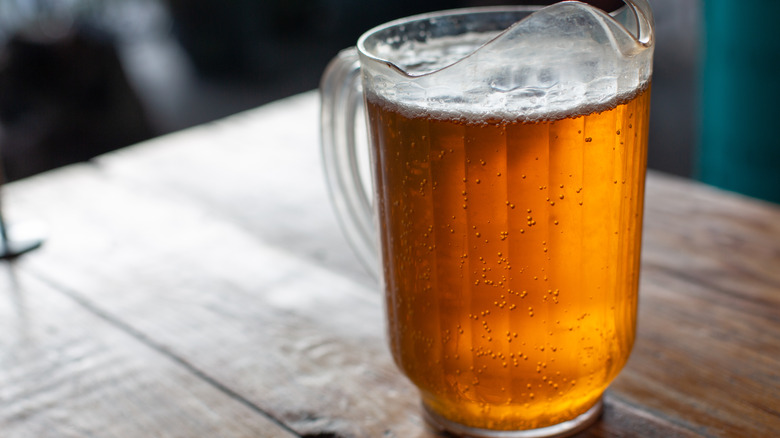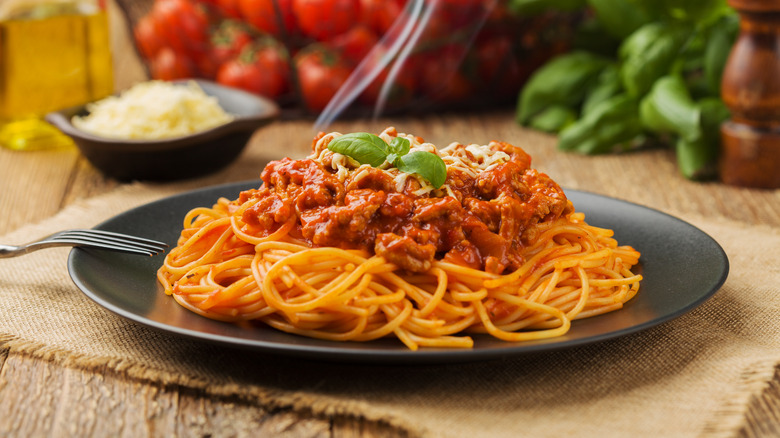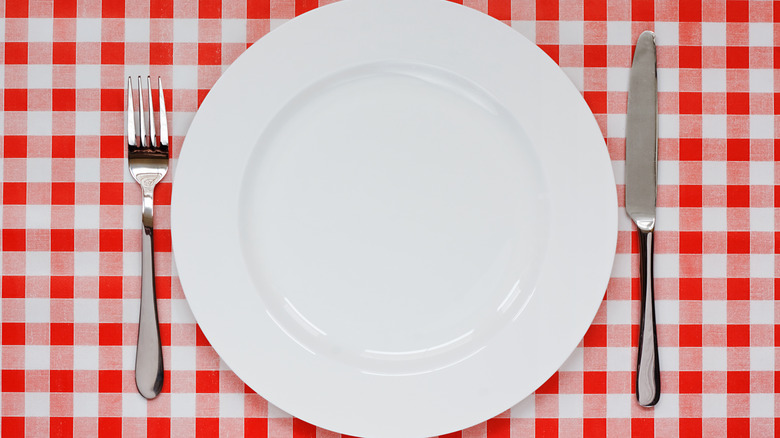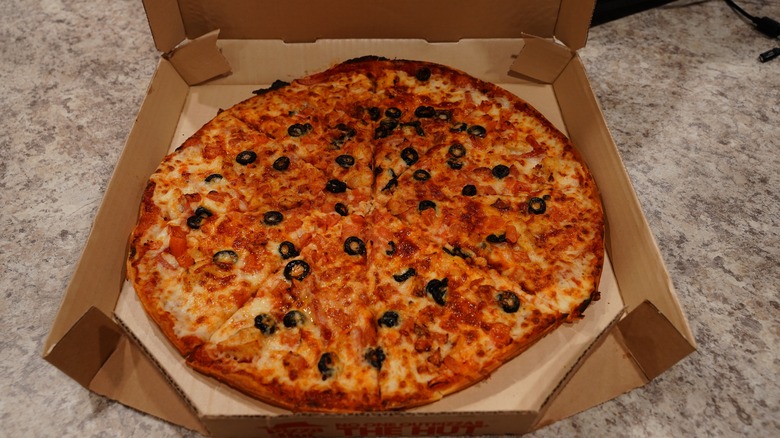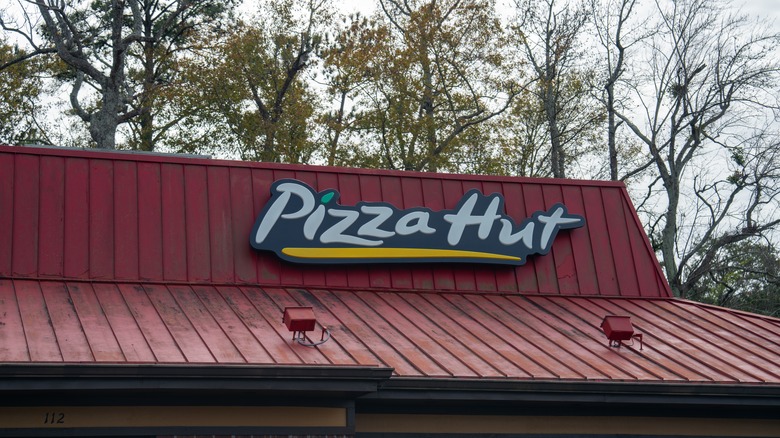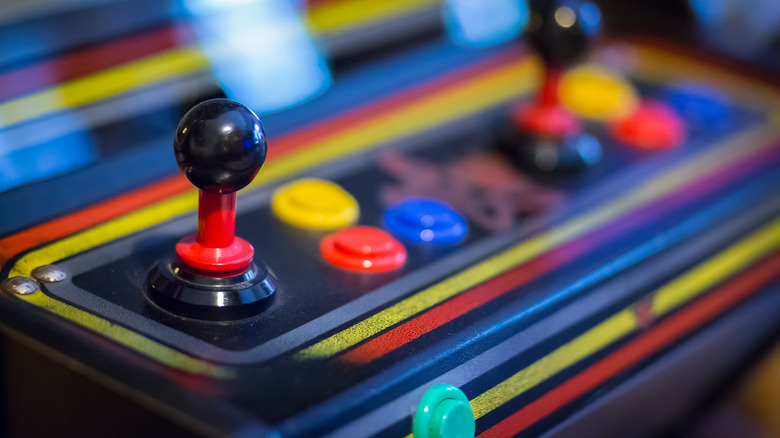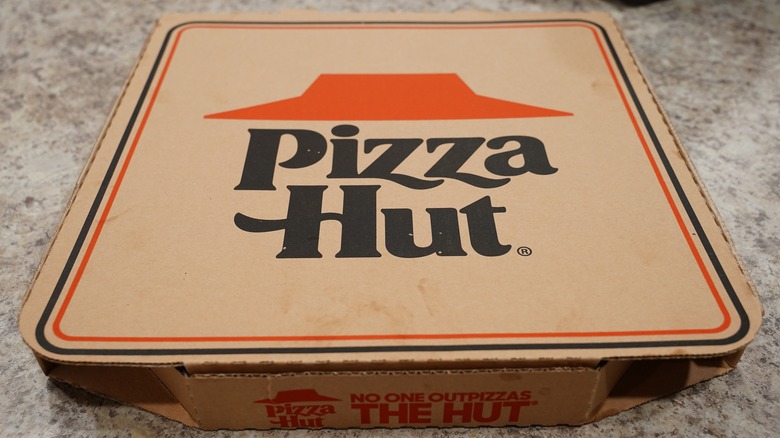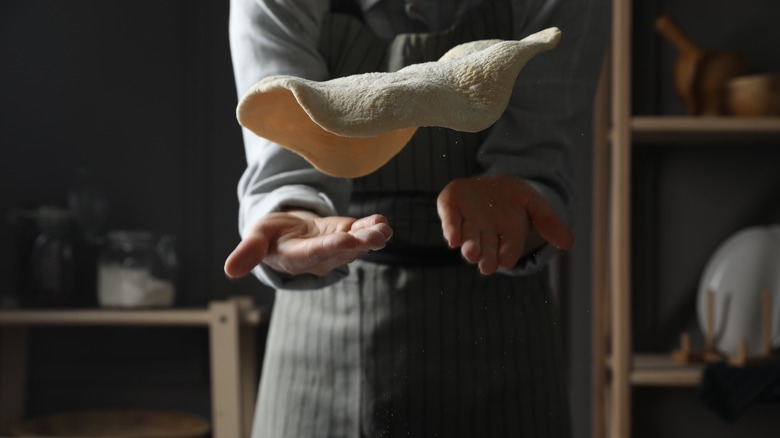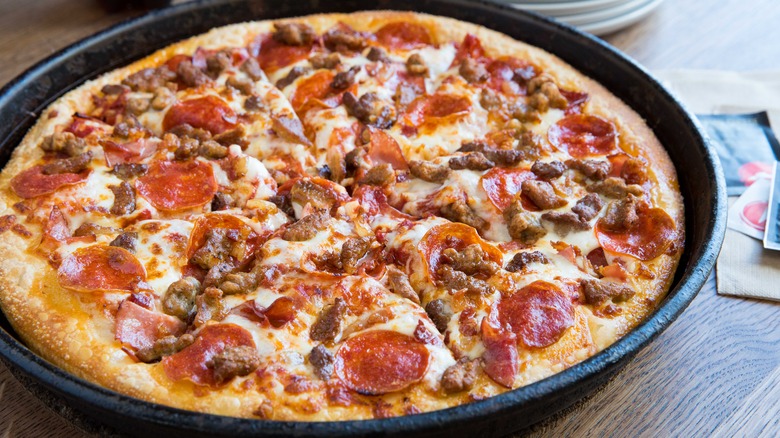What It Was Really Like Eating At A Pizza Hut In The 1970s
Pizza Hut has been a part of American life for decades, ever since Frank and Dan Carney created its convenient name and started offering its classic food back in 1958. Since then, it has served countless pizzas to hungry customers, with a virtually unlimited number of flavor and topping combinations. Arguably, the chain's heyday was during the 1970s. This decade saw the last few years before Pizza Hut entered into a merger with PepsiCo in 1977, and its vibe changed from homely and rustic to the convenient, fast-moving eatery that it is today.
Pre-merger, eating at Pizza Hut was a bit more like eating at your local Italian restaurant: The decor resembled that of a classic pizzeria, and it offered a number of menu items that it doesn't have today, like spaghetti and pitchers of beer. Its dough and ingredients were also treated differently. In the years since, some ex-employees have pointed out the care that went into making the pizzas during this period. On the flip side, Pizza Hut's '70s menu was also missing some classic options that we know and love today. Let's take a trip back in time and see what it was really like to eat at the Hut during the decade of flares, boho dresses, and good old-fashioned pizza.
You could order beer by the pitcher
These days, eating at Pizza Hut is typically a sober affair, but this wasn't always the case. In the '70s, Pizza Huts across the land stocked draft beer, alongside the restaurant's soft drinks, iced tea, and somewhat curiously, milk (which you could order in either a small or large glass to drink with your pizza). You could buy beer by the glass or the pitcher, similar to the chain's soft drink offerings.
What's noteworthy is how cheap Pizza Hut's beer was. You could grab a glass for just $0.40, and a pitcher was just $2.25. This made a pitcher only marginally more expensive than a pitcher of soda, which came in at $1.50. It's much harder to find beer at Pizza Huts today, and over time some stores have phased it out. However, the franchise has been known to offer it via delivery in certain states, particularly during major sporting events like the Super Bowl. Interestingly, though, locations in other parts of the world still stock alcohol. For example, if you're eating at a Pizza Hut in the U.K., you can still have your meal with booze, provided that you drink it in-store.
Your pizza's dough would have tasted different
Like all chain restaurants, Pizza Hut has to offer plentiful food at an affordable price, and menu items must remain consistent across locations. It may have nailed its system for this. But, unfortunately, this may have come at the expense of quality for some folks. Pizza Hut ingredients — specifically its dough — appear to have been way more carefully crafted back in the '70s. Nowadays, Pizza Hut is using frozen dough, as revealed by a former employee on TikTok. In the '70s, though, Pizza Huts would make fresh batches of yeast-risen pizza dough in-house, according to a comment on Quora from an employee that worked there during the decade.
While it's unclear exactly why Pizza Hut elected to stop using fresh dough, it likely has something to do with their rapid expansion. It's not just the dough that people have recognised has declined in quality, either. Folks over on Reddit have pointed out that the ingredients generally felt more expensive and tasty back in the '70s, and through to the '80s. This appears to track with its move away from a more intimate dining experience in its restaurants, and a more fast food-focused approach.
If pizza wasn't your thing, you could get some spaghetti
Anyone who's eaten at a Pizza Hut will know that it doesn't just do pizza. Pasta is available in several forms on the Pizza Hut menu, with various oven-baked options catering for vegetarians and meat-eaters alike. In the 1970s, though, the restaurant was taking it to a whole new level by offering spaghetti. Its Deep Dish Spaghetti was a rustic combination of meat, tomato sauce, and cheese, and came in at $1.99 for a regular size. This reasonable price made it one of the cheapest items on the menu.
The Deep Dish Spaghetti was available at both lunch and dinner time, with the Luncheon Size costing just $1.49. If Spaghetti wasn't your thing, you also had several other pasta options you could opt for. Pizza Hut offered its Cavatini and Cavatini Supreme Deep Dish Pastas at a similar price point, with the Supreme version amped up with pepperoni, green peppers, onions, and mushrooms. The regular Cavatini pasta, meanwhile, had a cheesy mozzarella topping and came with a spiced tomato sauce. If all that wasn't enough, every portion of pasta came with a side of garlic bread, with no additional charge. Someone get us a time machine!
The interiors were way more authentic
One of the main differences between eating at a Pizza Hut in the '70s, and eating in one now, is how everything would have looked. Pizza Huts back then were way closer to a traditional Italian restaurant in their style, with red-and-white checkered tablecloths and curtains and walls made from exposed brick. The booths, meanwhile, were lined with wood paneling, and the ceilings had beams in them, contributing to the rustic experience.
Red and white is a common color scheme in Italian eateries, and is meant to evoke the two different wines that are popular with the country's cuisine (and potentially to convince folks to try out the restaurant's favorite variety). While this psychology won't have quite worked at Pizza Hut, given that wine wasn't on the menu, it does help to give it that authentic feel. When you compare its interiors with how they look nowadays, the difference is pretty stark. Although Pizza Hut has retained red and brown notes in its decor, everything's way brighter and airier instead of cozy. The tablecloths and checks, meanwhile, are nowhere to be seen, and trendy pendant lighting now dominates their spaces.
You would have had two options for your pizza's thickness
These days, the pizzas come in many different shapes and sizes at Pizza Hut, with hand-tossed, stuffed crust, thin, and gluten-free options all available from the restaurant. Back in the 1970s, though, things were more simple — but no less delicious. You had two options for your pizza's thickness, and could choose from either a "Thin 'n Crispy" or a "Thick 'n Chewy" version. While thin crust is still a firm favorite on the menu, the Thick 'n Chewy style has is now one of those discontinued Pizza Hut items that is no more (and has been replaced by the Pan Pizza, which offers a thicker, chewier base and crust).
What's also notable is how many options Pizza Hut offered for topping combos. This is nothing new, of course. Pizza Hut has always allowed folks to customize their pizzas with a huge variety of flavors. But these days, it tends to promote a few specific recipes as its primary output. Back in the '70s, all of its options were front and center on its menu. Customers could keep it simple and go for a pizza with just olives, onions, or Canadian bacon. Alternatively, they could go for broke with the Pizza Hut Supreme, laden with pork and a variety of veggies.
You'd be sitting under its iconic red roof
Think of Pizza Hut, and you likely think of its timeless red roof. The distinctive hat shape was a fairly new feature back in the '70s, having been introduced to its store in 1969. Like the McDonald's Golden Arches, it was a great way for Pizza Hut to stand out from the pack, and coincided with the restaurant's expansion into international markets. Founders Frank and Dan Carney began to think about how they could distinguish their restaurants and make them immediately recognizable to customers, and engaged the services of friend and architect Richard D. Burke.
Burke was paid $100 per store for his iconic red roof design. The roof was inspired by the restaurant's 1950s origins, and it quickly became one of the most recognizable parts of the brand. In fact, Pizza Hut adopted the hat shape as its official logo, which is an essential part of its branding to this day. While some red roofs remain, many locations have taken on more streamlined looks to fit with the aesthetics of their surroundings.
Your kids would have been entertained
Pizza Hut has always been a family affair, and this was as true, if not more, in the 1970s than it is now. Back then, Pizza Hut restaurants were particularly well-versed in keeping your kids entertained, and restaurants often had various arcade games in-store. As you ate your pizza, your kids could busy themselves playing against their friends, with the games on offer getting more and more sophisticated and extensive as time went on. Their parents, meanwhile, could kick back and chat with each other while sipping a cool beer.
Other former diners over on Reddit have pointed out that Pizza Huts were also often equipped with jukeboxes, letting your kids (or you) decide exactly what played as you ate. This sense of it being a haven for little ones isn't something that stopped in the '70s. Pizza Hut continued to accommodate kids long after that, with the restaurant debuting a "Kids Night" in the 1990s where the kids were given free Nickelodeon magazines, and free personal pan pizzas with an adult order. What's notable, too, is the general vibe of eating in Pizza Huts during the '70s. The restaurants had the feel of being neighborhood affairs where you could have a pleasant sit-down dining experience while mingling with neighbors.
Your takeout box would have been much more stylish
1970s Pizza Hut boxes almost looked like artwork. Each white box was adorned with black and red stripes down one side, creating an exciting visual contrast. On the front of the box was a drawing of Pizza Hut's mascot, Pizza Pete. While Pizza Pete has now receded into Pizza Hut history, there was a time when he was all over the restaurant's branding, before he was replaced by the iconic hat logo.
Perhaps most interesting (and helpful) were the reheating instructions displayed front and center on the box, which helped the customers enjoy their 'za long after it cooled down. These days, Pizza Hut takeout boxes are slightly less detailed, and while they still have the distinctive stripes running down the sides, Pizza Pete is nowhere to be seen. Pizza Hut has also experimented with a round delivery box in recent years, although we can't imagine it'll become a standard feature any time soon.
Your pizza wouldn't have been hand-tossed
One of the best parts of eating in a pizzeria is watching the chefs fling their dough high into the air, creating a perfectly circular shape. You wouldn't have seen this at Pizza Huts in the '70s, though. Pizza Hut didn't introduce its famous hand-tossed pizza until 1988. Before then, its pizzas would have been shaped directly in the pans they were cooked in, or on a flat surface.
Shaping your pizzas by pushing them down, instead of throwing them in the air, has a lower degree of risk — but it also changes your eating experience. Hand-tossing pizza stretches the dough more gently and stops it from being too overworked, which can occur when you're pushing it down and working it too hard. Stretching the dough on a flat surface also increases the risk of tearing it, and can also dry it out. Additionally, overworking your pizza on a flat surface can toughen it up, resulting in a chewier experience (which can border on unpleasant). Pizza Hut doesn't always hand-toss its pizza, even today, its Pan Pizza is shaped directly in the tray, but those who like a lighter crust will be pleased that they're not eating in the olden days.
Its famous Pan Pizza would be nowhere to be seen
The Pan Pizza is a staple of Pizza Huts around the world. In the '70s, though, it was just a speck in the eye of founders Frank and Dan Carney. Pizza Hut didn't start selling its world-famous Pan Pizza until 1980, when it was rolled out to every restaurant in the franchise. Before then, you would have had to make do with a Thick 'n Chewy pizza, which appeared to have the same dense base and crust that the Pan Pizza has.
So why did Pizza Hut create its pan crust pizza, if the Thick 'n Chewy version available in the '70s was pretty much the same thing? It all comes down to their appeal in certain markets. Back then, Pizza Hut was pretty unpopular on the East Coast, and the Carney brothers needed to figure out a way to make their restaurant stand out. Instead of trying to compete with the various pizzerias selling Neapolitan pizza, they decided to go in an entirely different direction. The Pan Pizza was born, the world had a brand-new pie to try, and it's remained a staple to this day.

